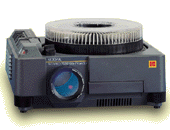Back in the dark ages (prior to the widespread availability of the ‘personal’ computer), my father worked in a corporate environment. There was always a push for the most up-to-date technology as a tool which could speed work, improve accuracy and even take out the garbage if you were willing to just spend the time writing code. Unfortunately, due to limitations of hardware at the time, that kind of coding eventually only produced a program that would flash “take out the garbageâ€on the screen at a given time and day.
One particularly impressive piece of technology available to staff: a “presentation†device. This device consisted of a series of rackmounted slide projectors which could be operated so as to give the effect of “transitions†between slides.
This amazing slide projector had cutting edge features such as a 1300 lm lamp; forward and reverse control of slides; an RS-232 serial connector;Â random slide access via remote control or computer; a built-in dissolve feature (0 to 10 seconds); and it weighed in at a feathery light 26 pounds. All this for a paltry $1,560 (lens not included). Surprisingly, the manufacturer did not include the most important feature in the press release materials: an amazing capacity to consistently overheat and crap out 5 min. into a 20 min. presentation.
computer; a built-in dissolve feature (0 to 10 seconds); and it weighed in at a feathery light 26 pounds. All this for a paltry $1,560 (lens not included). Surprisingly, the manufacturer did not include the most important feature in the press release materials: an amazing capacity to consistently overheat and crap out 5 min. into a 20 min. presentation.
The more things change, the more they stay the same. Recently, in the middle of trial, about to begin a cross exam of a witness, the TrialPad app, when reconnected to the cable at the podium, refused to display anything other than mirror mode.
The revolutionary software, this secret weapon, this huge advantage over my worthy but technologically handicapped adversary, was now not only worthless, but also a potential scuttling of my whole boat. Technology rigorously follows Murphy’s law: anything that can go wrong will go wrong.
Belt and Suspenders
In addition to having spare batteries for the remote, a spare bulb for the projector, a spare laptop/iPad in case it craps out, and your presentation on a spare USB drive you must have, more than any of these, a plan ‘B.’
Plan ‘B.’ The cross exam depended on a few key documents and prior testimony. Time to go old school. At every trial, the important exhibits (there should usually only be five and absolutely no more than ten of these) should be blown up and placed on foam board. Now, here’s the trick: get those blow ups laminated. This allows you to draw, write and highlight directly on the blow up with dry erase markers which can then be later erased. Next, always have a hardcopy of your exam outlines contained in your trial notebook. Last, always have hardcopies of the depositions. With these items in hand, you never need to worry that technology will fail you. You only need to question whether the time and money involved in technology are worth the the effort.
Note: The fatal bug in TrialPad appeared in a previous version and has since been corrected.

Peter first brought this to our attention in June (thanks!). It turned out that TrialPad 2.0.27 had a way you could get it into mirror mode, instead of just showing the active area, by following a very specific and unique set of steps. (We had been trying to implement this “feature†for training purposes.) We corrected this with TrialPad 2.0.30 which was released in July.
To add to the “Belt and Suspenders†advice, I highly recommend you follow the three rules of trial presentation: Practice. Practice. Practice.
Kind regards,
Ian
——————————–
Ian O’Flaherty
ian@litsoftware.com
Lit Software, LLC
Developer of TrialPad for iPad